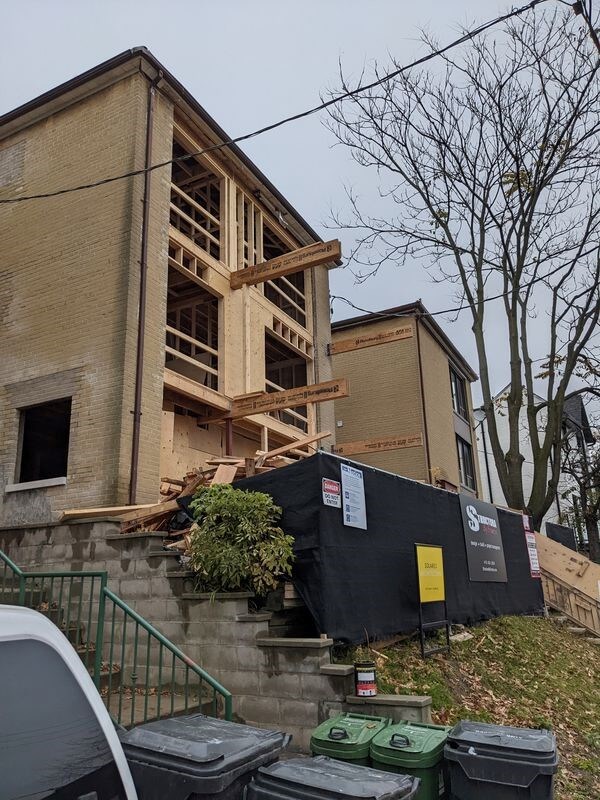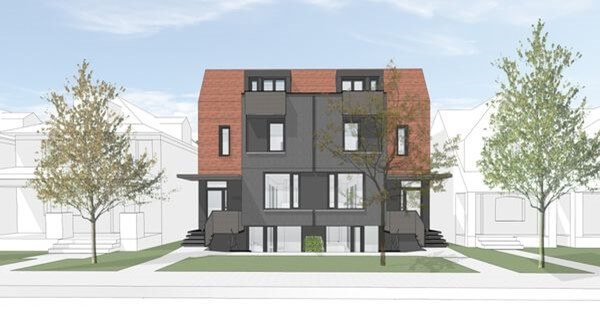THE GLOBE AND MAIL
JOHN LORINC
DECEMBER 16, 2022

SOLARES ARCHITECTURE
As Toronto sets out to loosen development rules to allow more density in areas that have been the domain of single-family homes, developers and planners are navigating an unfamiliar path with rules that still need to be fleshed out by planning officials.
Architects and contractors who have cobbled together a portfolio of laneway suite projects in the past few years are discovering that building garden suites – the City of Toronto’s latest attempt to add as-of-right gentle density to low-rise neighbourhoods – is proving to be anything but a garden-variety home improvement venture.
At Solares Architecture, which has built about half a dozen laneway suites, the firm’s designers are testing out various permutations on potential projects that aspire to create a self-contained dwelling behind an existing house, either as a rental unit or for extended and/or intergenerational families. But the restrictions in the city’s February, 2022, bylaw enabling garden suites – on set-backs, maximum floor space, roof treatments, angular planes, etc. – have posed challenges, say principal Christine Lolley and senior architect Melodie Coneybeare.
“The size is the biggest thing,” says Ms. Coneybeare, noting that the construction budget can be driven by the fact that backyards aren’t always accessible to heavy construction equipment. As Ms. Lolley adds, “Nobody understands how much these things cost.”
At the moment, Solares is working with one client on a garden suite in the High Park area – a corner lot that allows excavation equipment access to the backyard.

SOLARES ARCHITECTURE
A project by Solares will rejig the interior of a mid-1950s Toronto triplex to create an additional unit and more floor space, as well as a two-level, 1100 sq.-ft laneway suite at the back.
Architect Craig Race, principal with Lanescape, has two garden suites projects in his pipeline. One will be a rental, while the other will enable the owners to move into the smaller new unit while renting out the main house, which has several apartments.
Because the garden suites bylaw is so new, the City has received only 46 applications so far this year, with just three building permits issued and none completed. Mechanical engineer John MacKenzie has hired Mr. Race’s firm to design and construct one on what he describes as a “pretty useless part” of a property he and his wife own in the Bathurst/Cedarvale area. They own and live in a 1950s-vintage four-plex on Markdale, a street lined with these types of dwellings, many of which now have six or seven units.
They all have paved rear areas, and his plan is to build a 1,500 sq-ft. dwelling back there and rent out the four-bedroom apartment in the main building that he and his partner currently occupy. “It’s much too large for us,” he says. “We want to get it back into the rental market.” Their application is going to committee of adjustment in the spring.
The experiences of these early adopters will set the stage for other investors and homeowners who may be looking to take advantage of the city’s apparent new-found appetite for intensifying Toronto’s far-flung house neighbourhoods.
In early December Mayor John Tory tabled an ambitious “housing action plan” that will include, among other elements, official plan policies allowing the development of duplexes, triplexes, fourplexes and multi-tenant houses in any neighbourhood, including those previously zoned exclusively for detached homes. Such dwellings have long been part of the fabric of Toronto’s pre-World War II neighbourhoods, but were largely banned in the post-war suburbs.
Mr. Tory’s plan needs to be fleshed out by planning officials but council approved the high level goals at its meeting on December 14.
In decades past, Toronto’s house neighbourhoods were far denser and more populous than they are today – a consequence of shifting demographics, house prices and declining family size. Earlier efforts to add density – e.g., with secondary suites – met with opposition from homeowner groups and sympathetic city councilors, although many homes across the city had basement apartments or multiple tenants living under one roof illegally.
Basement apartments were legalized across the city about a decade ago, and council in 2019 adopted the laneway suites program, which allows owners to build a rental laneway house on a lot with adequate access for fire crews without incurring development charges.
The laneway suites policy has met with growing success, although the numbers are very small relative to overall housing shortages and these units – which tend to cost at least $300,000 to build and command rents that can run to $3,000/month or more – can’t be described as affordable.
According to city officials, 199 laneway suite building permits have been submitted so far in 2022. Of those, 90 are under review, 97 permits have been issued, 38 are under construction and two have been completed.
Nor are the applications a slam dunk. A study released by the planning department in June, 2021, found that of the 306 laneway suite applications that had been received since the program went into effect, 185 required minor variances, many involving landscaping. The Committee of Adjustment approved just under two thirds of the appeals it received.
The city has since tweaked elements of the laneway suites bylaw that had proved to be unnecessary impediments, and will likely do the same with the garden suites program.
The restrictions on garden suites are more onerous than with laneway suites. While there are thousands of large lots across the city, the maximum footprint can’t exceed 645 sq.-ft, and the roofs need to be pulled back, creating second storeys that can have three and sometimes four angled interior walls with small dormers. “It’s more of a challenge to make a garden suite attractive compared to a laneway suite,” says Mr. Race.
Mr. MacKenzie says that with his project, which he expects will cost about $550,000, the angular plane rule could reduce the second floor area by as much as 20 per cent. The requirement makes little practical sense, given that the proposed building will only overlook the rear paved areas behind the neighbouring four-plexes, he says. “It’s literally just parking or nothing.”
As Ms. Coneybeare says, “We don’t need angular plans to hold back liveable space.”
Toronto’s tight restrictions, promulgated to minimize pushback by neighbours and residents’ associations concerned about privacy, stand in stark contrast to the approach used in cities like Portland, where accessory dwelling units, as these structures are also known, come in a wide range of styles and forms, and have produced an outpouring of innovative design.
Yet the designers pushing the envelope with these kinds of infill projects point out that the city’s planning department seems to be paying close attention to what’s been working and what’s not with these bylaws, and has been open to making course corrections.
“One thing I always tell my clients is that there are nitpicky things in the bylaw that are annoying to deal with,” says Mr. Race. “But you should be extremely thankful that you get to build a second house in your backyard without paying any development charges. We shouldn’t complain about the annoyances of something that’s intended to protect our urban space.”
The multiplex industry stirs

ROLF PALOHEIMO
Builder Rolf Paloheimo is developing a 12-unit rental project with 26 bedrooms in all on the site of an unusually wide and deep residential lot on Gerrard Street East, in Toronto’s Upper Beaches neighbourhood.
Call it anomalous intensification.
On a small but growing number of quirky residential sites, independent contractors and landlords are figuring out how to leverage the city’s gradually evolving zoning policies to develop projects that are the contemporary equivalent of the low-rise apartment buildings which were once commonplace in older parts of the city.
For instance, on an unusually wide and deep residential lot on Gerrard Street East, in the upper Beach, builder Rolf Paloheimo is developing a 12-unit rental project with 26 bedrooms in all – a pair of fourplexes overlooking Gerrard, with two or three bedrooms each, plus two laneway houses out back, each with three bedrooms.
The property, which he bought for $1.7 million in 2019, currently has a single-family home with a tenant. He bought it in 2020, attempted unsuccessfully to sever it, and then came up with a new vision that he could develop as-of-right. The reason? The size of the lot – 50 x 140 ft – allows for plenty of floor space, and a rear laneway enabled him to think about rear-facing units. As a bonus, it sits on a streetcar line.

ROLF PALOHEIMO
Currently the site of a single-family home with a tenant, the Gerrard Street project will see the construction of a pair of fourplexes, with two or three bedrooms each, plus two laneway houses out back, each with three bedrooms.
Given that the lot is close to pricier residential real estate off Gerrard, Mr. Paloheimo reckoned he could try to sell the laneway suites as condo. “We thought about it but felt this was the right way to go.” He says he wouldn’t want to be marketing condos now anyway. While he’s expecting to pay somewhere between $550,000 and a $1 million on development charges, Mr. Paloheimo points out that the total cost per square foot will be about $600, while high-rises now exceed $1,000.
The math, he says, works. “I think these will be sought after.” But despite the location, transit access, the gentleness of the density, such projects still demand a lot of patience. “It’s so hard to get it done.”
Another example: a mid-1950s triplex that is notched into the escarpment that runs north of Davenport in the Regal Heights area. The owner has hired Solares to gut and re-jig the interior to create an additional unit and more floor space, as well as a two-level, 1100 sq.-ft laneway suite at the back that will actually sit at the same level as the top floor of the main building because of the lot’s steep grade. The project will also be entirely electric, with no gas.
The two-bedroom laneway unit, explains Solares principal Tom Knezic, “is a density boost.” And, he adds, it will be oriented towards Regal Heights instead of Davenport. “From the street, it looks like a one-storey laneway.”
Mr. Knezic points out that such properties have a lot going for them: existing infrastructure, good bones, zoning that now allows for this kind of project. “There are so many of these little projects,” he says. “I think that’s the future.”
